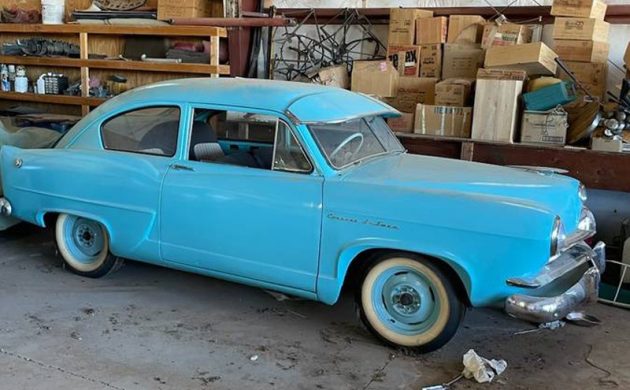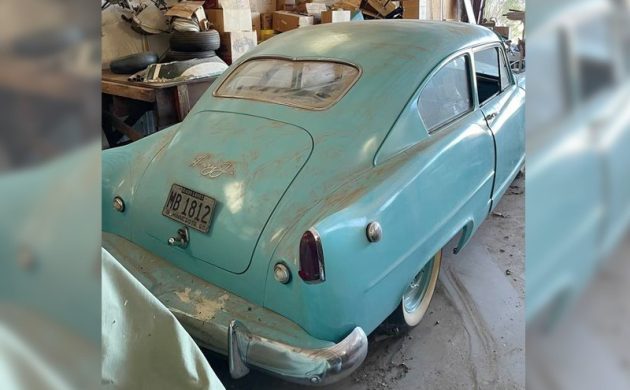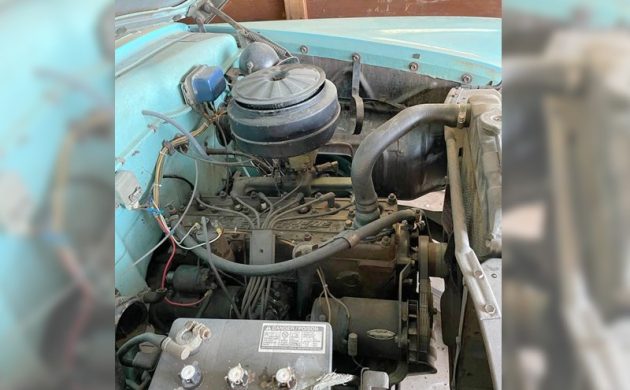We have seen a few Henry Js here on Barn Finds over the years, but only two 1953 models. As is almost always the case with car companies, they had worked through some issues by the end of the run. This 1953 Henry J Corsair DeLuxe is posted here on craigslist somewhere in the southwestern Arizona area and they’re asking $8,500. Here is the original listing, and thanks to T.J. for the tip!
It was getting close to the end of the line for this model by 1953, and as is usually the case, they were getting the bugs worked out. The later cars were some of the best ones produced – think Pontiac Fiero and any number of other models that were close to perfection before they pulled the plug for one reason or another.
Kaiser-Frazer Corporation was a powerhouse at one time and the company wanted to produce a car that a family with a modest income could afford to buy new, rather than buying a used car. As such, early models were bare bones, with no trunk, fixed rear windows, and other things that most buyers took for granted. They weren’t much cheaper than some other models with those features and were made from 1950 until 1954.
You can see that this Corsair DeLuxe (DeLuxe = six-cylinder) has an outside opening trunk and it appears to be in really nice condition. Clearly having been repainted in or close to its original Cerulean Blue at some point (overspray at window trim), we don’t know any history of this car at all other than the seller saying it hasn’t been run for three years. The interior looks good from what we can see from the passenger side, and the close-up of the gauge cluster is a nice touch since I’m guessing the driver’s door wasn’t accessible.
The engine is a Willys-Overland 161-cu.in. L-head six with 80 horsepower. This car looks great overall and yes, the wheel covers are included. There’s not much information in this listing but the car sure looks good. Hagerty is at $11,400 for a #3 good-condition car and $7,900 for a #4 fair example, just for reference. Are there any Henry J fans or owners out there?








I saw my first Henry J when I was 9 yrs old in 1957 visiting distant relatives in Baton Rouge one winter. The father and son were in their garage working under the hood of this tiny car which was their used Henry J. They were tearing down the engine because the boy dropped a socket or something in the motor while they were working on it or rebuilding it. Didn’t see too many small cars on the streets in those days, so this was a pretty strange looking car to me. But as an adult going to car shows, I have really liked seeing them. Great car to modify for the drag strip.
That’s why there aren’t many left. They’ve all been cut up to make dragsters.
Those aren’t car people, by any definition.
This looks really nice, if you want one this is the one to buy. Shouldn’t be too much to get it up and running again and there aren’t too many left. I agree the biggest reason small cars didn’t sell in big numbers back then was you could buy a stripped down Chevy for almost the same price. And there was Competition from some of the other independents as well. Nash with the Rambler, Willys with Aero and Hudson with the Jet. Ford made a prototype small car but found it cost almost as much to make as a full size one. It looked like a scaled down Mercury with the small 60 h.p. V-8. That ended up going to France as the Vedette I believe. I didn’t know that Kaiser used 2 different 6cyl. motors. A smaller one for the Jeeps and the Henry J and the larger Contiental for the bigger cars.
Yes, you could have purchased a Chevy for $200 more……because of the predatory price war with Ford, which many feel was a deliberate effort by the two majors to drive smaller companies out of business. It worked.
At the same time, Chevrolet had its “Cadet” ready for production. As you say, the bean counters did not like the hit on profits, and in GM speak, “Small cars =Small Profits”. True, but they left the segment open to imports, and that didn’t work out so well. Note: McPherson Struts were developed for the Chevy Cadet.
Ford had a compact car called “Cardinal” in the early sixties. (Cardinals eat beetles, get it?). A small front wheel drive sedan with a V-4 motor, it was going to be produced in 1965 in a factory in Kentucky. At the last minute, the car was cancelled, and the production was shifted to Germany, where it became a Ford Taunus
Imagine how different the North American market would be today had Ford had an excellent small FWD sedan to sell in the late sixties and early seventies. Americans didn’t buy small cars from Detroit, because they chose not to make them to preserve more profitable larger cars………
Oh, I dont know, the Falcon, Corvair, Chevy II , Valiant ,Dart ,and the American all sold very well. they were the compacts of the era. I doubt a front drive v4 would have sold well in the U.S at that time as “different” wasn’t what people were really looking for Ford couldn’t’ even get the Cortina to sell well here , and that was a rear drive car. . Foreign front drives did not sell well over here ; the Beetle, with its rear drive did
Last year I was looking for a Sears Allstate project car and spotted one in the woods near my house. When I walked through the woods closer to it, it turned out to be a non-trunk, complete but rusty, Henry J.
I read, and if I may add, ’53 was the 2nd series car, and had many of the options the Allstate had over earlier Henry Js. I saw, how the name came about. When the car was introduced, it had no name, and a contest for the workers could name the car. Henry Kaiser was well liked, treated his employees fair, and it was unanimously named the Henry J, in honor of him. This car sold new for $1343, $1219 for the 4 cylinder, Allstates, which were a dud, a bit more, and this was a much improved car, but plans for the new Aero, also a dud, killed the Henry J. A great find, also I read, the Corsair Deluxe with the 6 had the optional O/D, although not mentioned, if even known about, and with the 6 should be adequate at 55 anyway, and not some hemi powered, fuel guzzling tank. Still a really nice car, even for today.
All I have to say is “Henry J Drag Coupe.” They were the coolest! Google it.
This could have been the American rival to the wave of imports that was arriving on American shores. The VW Beetle, British Fords, and even the Renault Dauphine were selling well.
The car was really “bare bones” at first, and it became viewed initially as kind of a “Blue Light Special,” but for Sears customers. As they increased features, Ford and Chevy went into a devastating price war, and you could buy a BelAir for about $200 more, killing the sales of a sensible American compact car in the US market. The Henry J did sell well in Brazil, where Kaiser had a big presence due to Willys and Jeep sales.
Kaiser had deep pockets and decades of experience manufacturing war materiel and even ships, yet he could not compete in the post war automotive industry. Kind of tells you that Tucker, with virtually zero experience didn’t stand a chance
Only the Beetle sold well and actually could hold up here, the Renault Dauphine and the British Fords were a rare sight and were not very popular ; thats why they stopped importing them . The Henry J was a good idea that no one was interested in. Like the Jet , it made more sense to buy a bigger car with more options for the same money as a little stripper car like this. there wasnt much of a “wave” of imports in 1953 , but maybe if Kaiser had introduced a compact in 1958 during the recession they would, for a time have sold well , before the better Rambler and Lark compacts made their debut, and the big 3s in 1960
There’s a yellow ‘53 roving around Prescott, AZ. A real head turner.
We had a yellow Henry J with a “full house” b block ford flathead that we us3d to race in G Gas.
Make a great gasser
That’s how I remember these in the 60’s and 70’s
Those things would literally hop off the ground at Lion’s Dragstrip, in Long Beach , CA.
What was best ET and speed in 1/4 mile strip?
Not sure what the best et was but there was a purple Henry j gasser with a hemi at English town that wheel stand half way down the track and the dude never lifted off throttle big wheelie bars in back sparking the whole way
Looks like a very clean ’53. The ’53s are very easy to keep running as they have all Delco-Remy electrical systems, same as many GM cars, and as pointed out, most engine parts are available from Willys vendors. The transmission is a Borg-Warner and if it has overdrive, it’s the same one used in Willys and Studebaker cars with plenty of parts availability.
Nash had the right idea with the first Rambler, which was a luxury convertible loaded with every option, and buyers bragged about buying one. The lower-end models came later after its “classy” image was solidified.
That lesson didn’t rub off on Kaiser’s Henry J, Yugo and Crosley, all of which appealed to a low price at first with their upscale models coming too late to change the public’s perception of cheap cars offering little pride of ownership.
Even with American’s disdain for tiny cars, I think Crosley was killed by a decision to use a motor with a stamped, brazed block instead of a conventional cast iron block. Even when they changed, the repetitional damage was done.
Yugo, also a subcompact, was killed by not being up to quality; reliability standards expected by US consumers.
The Henry J did have an image issue as a :cheap car, but I wouldn’t compare it to the two cars you mentioned. It was a larger, “compact,” at a time when GM and Ford’s price war drove smaller companies out of business.
Jimmy Novak are you implying drag racers and hot rodders are NOT car people?
WOW – Now thats funny stuff!
Anybody can run a blowtorch, but it takes determination to preserve automotive history, a genuine love and respect for the past, and a willingness to honor all the great automotive pioneers, engineers, stylists, designers, and even line workers whose hearts and souls went into those early motoring classics.
I always thought that the split windshield was history by 1953. Another off-brand proved me wrong again.
The 1954 Henry Js also continued with the split windshield, and Dodge Power Wagons used V windshields into 1968.
How do you put a value on something like this? I just don’t know how Lee Trevino makes it through life without being able to go the golf course everyday. Value to him. It all depends on what has value to a person. As I recall from the early 50’s these cars had little value to consumers. They were considered throw away cars at the time. Time has a way of giving value to vehicles like this that don’t end up crushed or turned into drag strip racers. I value all original low mileage luxury cars from the 60’s like my 1964 Buick Riviera.
A Henry J is near the bottom of my value list of cars. Value is what someone is willing to pay so good luck on this one.
God Bless America
I value my 1/64 scale diecast Henry J. Very affordable. Just wish they would have painted it a bright color instead of dark green. Lighter colors show the lines of the car better.